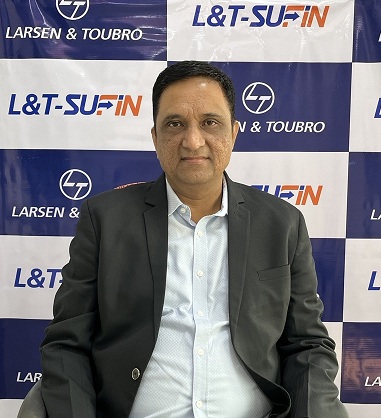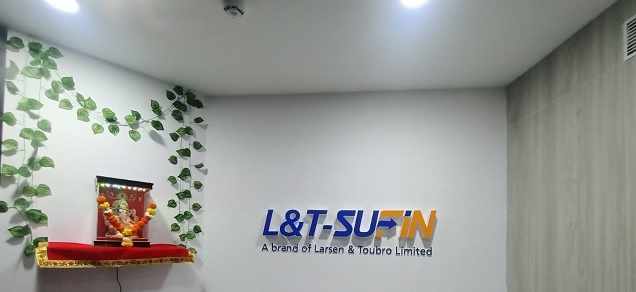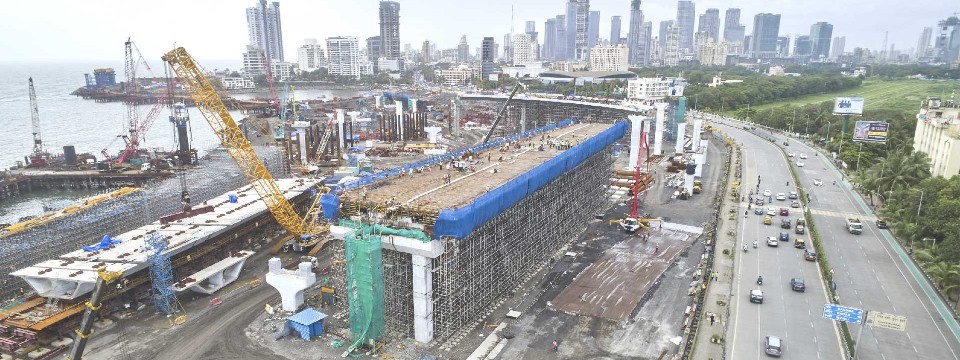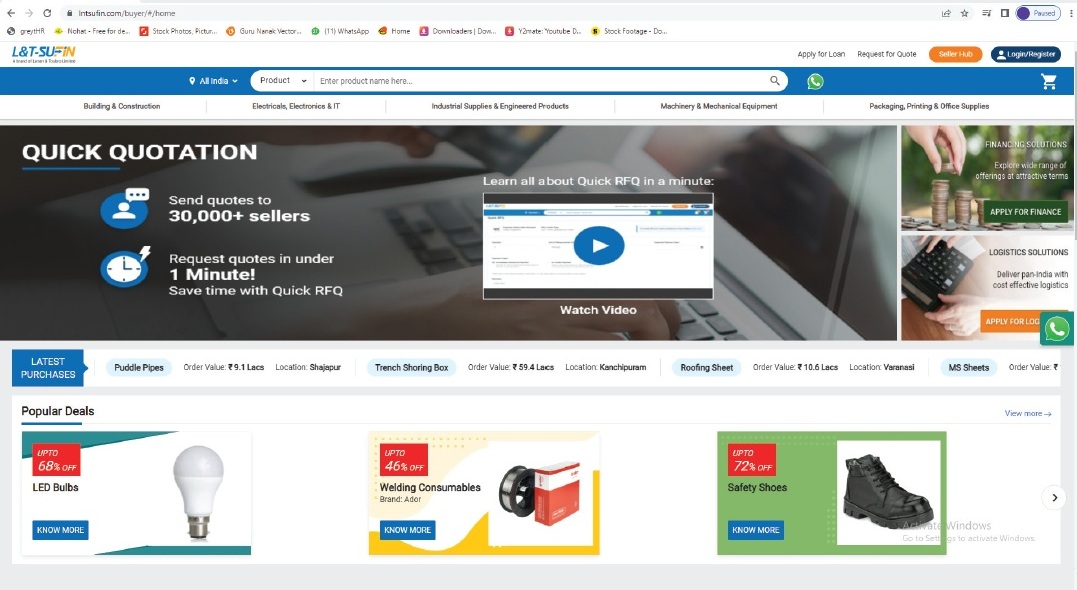 L&T-SuFin represents the entry of the engineering conglomerate Larsen & Toubro (L&T) into the B2B e-commerce segment, targeted mainly to small and medium enterprises. Bhadresh Pathak, Business Head, L&T-SuFin, in this freewheeling conversation with Venugopal Pillai takes us through this new enterprise –its genesis, development and the values that it seeks to stand for. Pathak asserts that though there is tremendous scope for B2B e-commerce in India, creating solid trust between buyers and sellers would ultimately determine success. Empowered by the vast experience of its parent L&T, Pathak exudes confidence that L&T-SuFin will be at the forefront of the B2B e-commerce revolution.
L&T-SuFin represents the entry of the engineering conglomerate Larsen & Toubro (L&T) into the B2B e-commerce segment, targeted mainly to small and medium enterprises. Bhadresh Pathak, Business Head, L&T-SuFin, in this freewheeling conversation with Venugopal Pillai takes us through this new enterprise –its genesis, development and the values that it seeks to stand for. Pathak asserts that though there is tremendous scope for B2B e-commerce in India, creating solid trust between buyers and sellers would ultimately determine success. Empowered by the vast experience of its parent L&T, Pathak exudes confidence that L&T-SuFin will be at the forefront of the B2B e-commerce revolution.
Let us start by understanding the rationale behind L&T’s entry in the e-commerce space.
L&T has always been in the conventional engineering business, which has been its core activity. The idea now was to also enter in technology-related businesses. This started with L&T Infotech and then we acquired Mindtree. Incidentally, both these units have since been merged and are known as “LTIMindtree”.
The primary idea was to enter into new-age technology businesses and L&T-SuFin is one of these initiatives. We started three initiatives in parallel – B2B ecommerce platform dealing with industrial goods; educational initiatives (edutech); and, setting up data centres. These are the three tech-related streams that L&T wanted to open up as new-age technology businesses.
Having established a track record of over eight decades in the core business, these are the new-generation businesses that the management strongly feels will drive L&T into the next level of growth.
As we understand, the idea of the B2B commerce segment was introduced in 2020 while the formal launch took place in March 2022. Take us through these two years.
An ideation group across the L&T conglomerate processed several possibilities and from there came the idea of B2B e-commerce. That was how L&T-SuFin was born, in 2020.
There was a debate on which company of the L&T Group should house this business. It was then decided to start this business as a division of the core Larsen & Toubro Ltd itself.
The core team developed a minimum viable product (MVP) and this was tested in 2021. At that time, we engaged with a lot of potential customers, took their feedback and then incorporated in the MVP. Then the actual development started. We actively ideated and made this platform over a period of one year – from February 2021 to March 2022.
It was a difficult period due to the pandemic. The developer team used to work from home; we used to work from home and meet largely through video conferencing. So, that is how these ideas got conceived and the product was finally handed over to us for commercial launch.
Just to reconfirm, is L&T-SuFin a subsidiary company?
No, it is not a subsidiary; it is a division of the main company Larsen & Toubro Ltd.
Can you summarize the categories you cater to?
Basically, the idea is to cater to the construction industry. The construction industry comprises of infrastructure developers alongside real and commercial estate developers. The other important segment is manufacturers. What we cater to mainly are MRO items – maintenance, repair and operations. These are not raw materials; these are more of spares and consumables that go into day-to-day operations. This is the boundary condition with which we started the platform. We have almost 50 categories of products with almost 3.5 lakh SKUs (stock keeping units) on the platform.
For instance, if we take “safety” as a category, we will have safety equipment like shoes, gloves, helmets, etc. If we take consumables, we will typically have welding electrodes, lubricants, etc. If we take “metals” as a category we would have MS sheets, like wise we have Pipes, Wires & Cables, Electrical motors, switchgear, etc.

What is L&T-SuFin’s offering for the power T&D sector, in particular?
We deal with various types of materials used in the building of transmission lines. Several items that the contractors often struggle to buy – transmission hardware like clamps, etc. – are available on our platform. Such material is very ordinary in nature but very difficult to get off the shelf.
Besides this, the main standard material like wires, cables, transformers and conductors, are always there.
For capital-intensive items, our platform might not be the right place but for smaller consumables that can potentially create a pain point for our buyers, the L&T-SuFin platform is the right place. Apparently, insignificant items like nuts, bolts, insulators, fasteners, etc. are generally not available when they are required but are very important!
“We have vast experience in dealing with MSMEs because L&T engages with a large number of MSMEs as suppliers and service providers. We have thousands of them and we have rich experience in dealing with them.”
We learn that L&T-SuFin is helping the MSME class not just with products but also with other services like financing. Tell us more.
You see, we have vast experience in dealing with MSMEs because L&T engages with a large number of MSMEs as suppliers and service providers. We have thousands of them and we have rich experience in dealing with them. The idea conceived was about helping MSMEs as they are a very essential part of the supply chain.
Because of typical problems faced by MSMEs, supply chains tend to become inefficient. MSMEs are unable to overcome these pain points. The first thing for MSMEs is the discovery of trustworthy suppliers. Or, to sell your products to the buyers whom you can trust. Trust is very important since all these deals happen on credit. It does happen on “cash and carry” model as we see on popular online shopping portals.
It is therefore very essential to have an entity in between to create this trust.
Banks traditionally played this role through bank guarantees, letters of credit, etc. But they are costly and time-consuming options and cannot be availed by all MSMEs. It is therefore very essential that MSMEs have a trustworthy partner as a mediating entity.
Now, as regards the MSMEs on the platform, we weed out those entities that are not disciplined or not very quality conscious. Plus, there are many fraudulent entities that try to cheat. These are also weeded out by the platform by the due diligence that we undertake.
In other words, you are essentially creating the trust factor between buyers and sellers…
Yes, when you are dealing with the L&T-SuFin platform, you are dealing with a reliable entity. Your money will not be lost. We have a network of relationship managers all across the country. That is where the trust comes from.
Second is about the payment. You handle the payment through the payment gateway so that there is an easy reconciliation of your receivables. The transaction history gets recorded; there is a due date by which the platform reminds the buyer to make the payment, etc.
What about the logistics support?
You pick up goods to the seller and deliver it to the buyer in a cost-effective manner. On all national routes – long distances – we are quite cost-effective. In local deliveries, we work with delivery agents equipped with two wheelers. Typically, the seller sends his delivery boy on a bike to deliver the goods to the buyer. However, here, the reliability and transparency could get a bit compromised. This is an area that we are working on.
All the same, the platform’s logistics support becomes a convenience factor to buyers. Through the platform, the buyers know when the goods are arriving. This gives them immense confidence.
Is there any other form of support that the platform lends?
Yes, there is also working capital finance through our financing partners.
How does this work? Do you provide the working capital support per se?
We don’t provide the finance as such; it is not on our balance sheet. Banks have partnered with us. So, say a buyer wants to buy on credit terms, he gets a “buy now, pay later” scheme. You see such things on shopping platforms. However, on our platform, the goods are usually of higher value unlike B2C platforms. We therefore need to do a proper due diligence before making that facility available to buyers. Similarly, if a seller gets an order and does not have working capital to produce the goods, he would also get working capital through our banking partners.
We also provide invoice discounting as well as channel finance to mid-sized companies.
How does that work?
Suppose there is a company with say a sales turnover of Rs.300-400 crore and it wants to expand its distributor network. They have to provide credit to the distributors and this could mean working capital requirement. Such channel financing is also done by banks associated with the platform.
How many banks are onboard right now?
Right now, we have about eight major funding partners comprising banks, NBFCs (non-banking financial companies), fintech players, etc. Most active of these are private sector entities.
As you said, L&T-SuFin is creating the trust factor between suppliers and buyers. Tell us about how you audit and vet the entities associated with the platform.
The first thing is verifying credentials like PAN, GST, etc. This part is done digitally. This is the basic check.
We then undertake physical verification; whether the seller is actually dealing with the goods that have been declared on the platform. We also see the financial track record and look for adverse developments like bank defaults, cheque bouncing cases etc.
I must add here that suppliers can get themselves registered on our platform freely, but we provide a “verified and trusted (V&T)” seal only after we undertake the due diligence. A buyer can deal with non-verified sellers at his own risk and responsibility.
Are manufacturers also part of the seller community on L&T-SuFin?
Even when manufacturers come on board, they distribute products through their dealers. Large companies do not sell goods themselves; they do it through distributors. So, we have to onboard distributors. OEMs will be there to showcase their brand but the order fulfillment is done through the distributors, for large companies. In mid-sized companies, there is a direct project or marketing division, which fulfills the order.
Several manufacturers – small or large – have their own sites and apps for making online purchases. Does a platform like L&T-SuFin create duplicity?
Yes, several manufacturers, OEMs and even traders do have their own websites or apps. They think that if they have a presence on the web, orders will flow in. But how to handle, what happens after the order or enquiry is generated is something that they haven’t thought through properly. There is usually no mechanism to conclude the order or to even confirm the veracity of the buyer.
After all, manufacturing products is the core business of such companies; creating digital platform is not.
In our platform, we have the unique feature called Request ForQuotation (RFQ), which such sites or apps usually don’t have. A buyer who comes on our platform can request quotations from suppliers. Such RFQs can be generated for hundreds of products at a time.
On our platform, RFQs are sought. The buyer selects the best quote, and based on this, a contract/purchase order is created that is sent to the supplier for confirmation. It is only after this that the contract gets concluded.
For a typical project, do you see a platform like L&T-SuFin contributing to lower time and cost overruns?
 Yes. There is a primary difference here. If you take a large OEM, there would be rate contracts and procurement would be made directly from suppliers. However, for a project, it works differently. In a project, there could be thousands of items that you need to procure, and the success of the project depends on these products. Now, not all of these products are easily available. This is where a platform like L&T-SuFinbecomes very relevant.
Yes. There is a primary difference here. If you take a large OEM, there would be rate contracts and procurement would be made directly from suppliers. However, for a project, it works differently. In a project, there could be thousands of items that you need to procure, and the success of the project depends on these products. Now, not all of these products are easily available. This is where a platform like L&T-SuFinbecomes very relevant.
For instance, we received an order for 50 washing machines from a cement company that was setting up a new plant. For products that are not “core” business of the project owners, but are essential for the project’s successful completion, our platform proves to be very effective.
How many buyers do you have registered on the platform?
Currently, over 25,000 buyers have registered on our platform. However, the active buyers would be around 15 per cent of this. These buyers have completed even repeated purchases. Factors that influence their purchases could be competitive pricing, logistics support, fulfillment of their working capital needs, etc. – all of which is available on our platform.
Some of these products are there on the platform. But these are not highly “platformable” type of items. What the platform actually does is that it creates some kind of awareness of the products.
L&T itself is a manufacturer of several products, notwithstanding the moving away of the Electrical & Automation (E&A) business. What is the exposure of L&T products on the platform?
Yes, L&T have manufacturing divisions like L&T Valves, L&T Construction Machinery division etc. Some of these products are there on the platform. But these are not highly “platformable” type of items. What the platform actually does is that it creates some kind of awareness of the products. However, these products are sold directly and L&T does not rely too much on the platform for selling these products
Of course, if some buyer, say an EPC contractor, wants to procure valves, he can opt for L&T valves, but valves of other companies will also be listed. The choice would depend on merit. The platform—just like any other the L&T group concern — functions purely on merit.
I would like to add here that even L&T Finance is not yet part of the platform as a financial partner!
Do you have plans to take this platform to overseas suppliers or buyers?
Yes, this platform will eventually go overseas, for both buyers and sellers. We are right now tapping the India’s full potential. We haven’t even scratched the surface in terms of the domestic potential. As far as the overseas plans go, we will be operationalizing it over a period of one year.
Considering L&T-SuFin’s overall base of buyers and sellers pan India, do you have anything to say about the geographic concentration – metropolitan cities, tier-1, tier-2 cities, towns, etc?
Yes, I would say that our platform is not very metro centric as such. In fact, what happens is that when you go away from the main cities into B towns, this platform becomes very useful. In western India for instance, we are getting buy enquiries from small towns also. In normal course, such procurement would have to be made from cities, so our platform becomes very useful. We don’t have very high rural penetration (villages) as such.
I would say we get more success with buyers –rather than sellers — in remote areas. Suppliers are located more in cities.
Is L&T-SuFin potentially creating a platform for suppliers from small towns?
I would say we get more success with buyers –rather than sellers — in remote areas. Suppliers are located more in cities. If there is a supplier in a remote semi-urban area, he would not be used to digital platforms and he is likely to be a small supplier who sells his products locally. Typically, such suppliers, due to their sheer size, may not want to sell on a national scale. All said, we could potentially have OEMs from small towns—more than traders—who would like to use the platform for creating a national presence.
What is your vision for L&T-SuFin?
Our main aspiration is that we should be instrumental in developing a world-class supply-chain network through our platform. Because we are doing things digitally, the supply chain is bound to become more efficient. We intend to create so much trust in the dealing entities that the platform becomes their default option.
For us, it is just a beginning. In India, if this catches up and people rely more and more on such platforms, then probably, we can contribute to building an efficient supply chain.
China is thriving on the strength of an excellent supply chain and the scale of B2B e-commerce, which is at least 700-800 times of that in India. That said, we haven’t even scratched the surface within the country. India needs to create solid trust between buyers and suppliers. To this effect, we would need platforms like L&T-SuFin, and we would very much like to see ourselves at the forefront.



